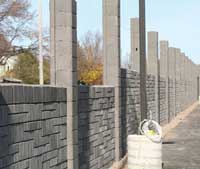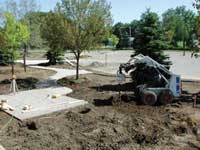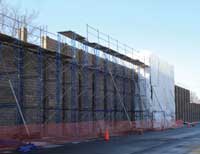Starting Your AB Fence Project on the Right Foot

Site Plan
A detailed site plan drawn to scale will help foresee design and construction challenges and provide an accurate reference for estimating.
All commercial and large-scale residential projects using the AB Fence require engineering provided by a qualified local engineer. While this information provides general guidelines, the actual construction drawings provided by a local engineer should be referred to for final requirements and specifications.
All Projects Start with a Plan
Before construction starts there must be a well thought out plan. Planning ahead will always save time and money in the end. The first thing to consider is what is the primary purpose or scope of the finished concrete fence? Is it a short seating wall, security fence, tall sound barrier or something in between? Although the construction of the Allan Block Fence is similar in all types of projects, the varied scope of a project may require a different level of planning.
Before Starting Construction

Concrete Piles
Once the project scope is set and understood, here are a few things to consider in the planning stage:
Where will the fence to be located?
Review the site to determine if the AB Fence System can accommodate the fence layout. Odd shaped angles and sharp curves in the layout may need to be redesigned or mitering of the fence post block will be required.
Are there any utilities on the site?
Utilities are any wires, pipes, cables or structures located below the ground surface. The presence of utilities are not necessarily a problem but they need to be located and clearly marked so they are not disturbed during construction. All states and provinces have “Call Before You Dig” hotlines that must be notified before any on site work begins.
Are there water management issues currently on the site or will there be some after the project is complete?

Fence Construction
Having knowledge of the current sites drainage will allow the designer to correct and plan for any water issues during final design and construction. Openings in the AB Fence Panel can be installed to allow water to flow through the fence when required.
What are the local code and permitting requirements?
Are there local height restrictions? How tall can the fence be before an engineered design, permit or even a variance is required? Are there setback requirements from the property lines? If an engineered design is required, what is the required wind pressure used for design?
Is a permit required?
It should be determined ahead of time what the city or municipality will require for the project approval process. In some cities, the approval process can take a long time to complete so the earlier the plan is submitted the sooner the project can begin.

Cornfirm On-Site Soils
Confirm the on-site soils.
The AB Fence pile footings rely on the soil to provide stability. If the site has soft, wet soils, or if the area was previously excavated, the foundation’s soil may need to be replaced with good material and firmly compacted. Building in poor soils can cause footing instability and future settlements. Work with a local engineer to confirm the soil conditions and footing designs.
Will the required concrete be delivered from a ready-mix plant or mixed on-site?
Be sure to plan for truck access or site space for the mixing equipment.
Is there adequate access to the site for construction equipment and material storage?
Poor access could require smaller equipment or even hand work to complete the project. Material storage is often overlooked. Having a plan for how much material is deliver at a given time and where it will be placed will provide a safer work environment and ultimately save time and money with a more efficient worksite.
Consider the local weather in the plan.

Fence Construction
What time of year will construction take place? Will cold weather building techniques need to be used or is it the rainy season? There should be a plan in place for weather related issues.
Confirm Inspection and Testing Requirements.
Depending on the design and local codes the project may require field inspection and testing to verify proper construction. Soil compaction tests along with concrete tests may need to be done by a third-party testing company.
Safety
Follow the guidelines for worker and job safety established by your local Health and Safety Organizations. Take special precautions for OSHA or CCOHS requirements, which include excavation and scaffolding. Material Safety Data Sheets (MSDS) for materials used in construction of the AB Fences are available from the local manufacturer.

